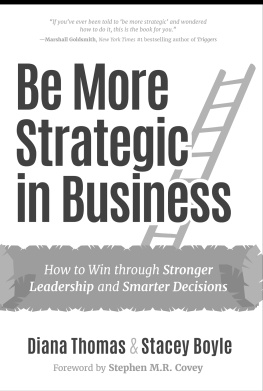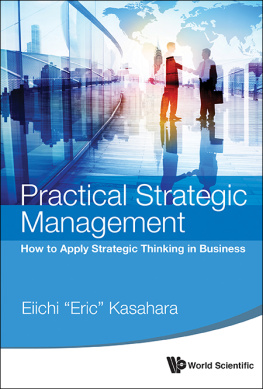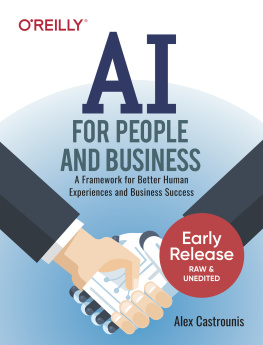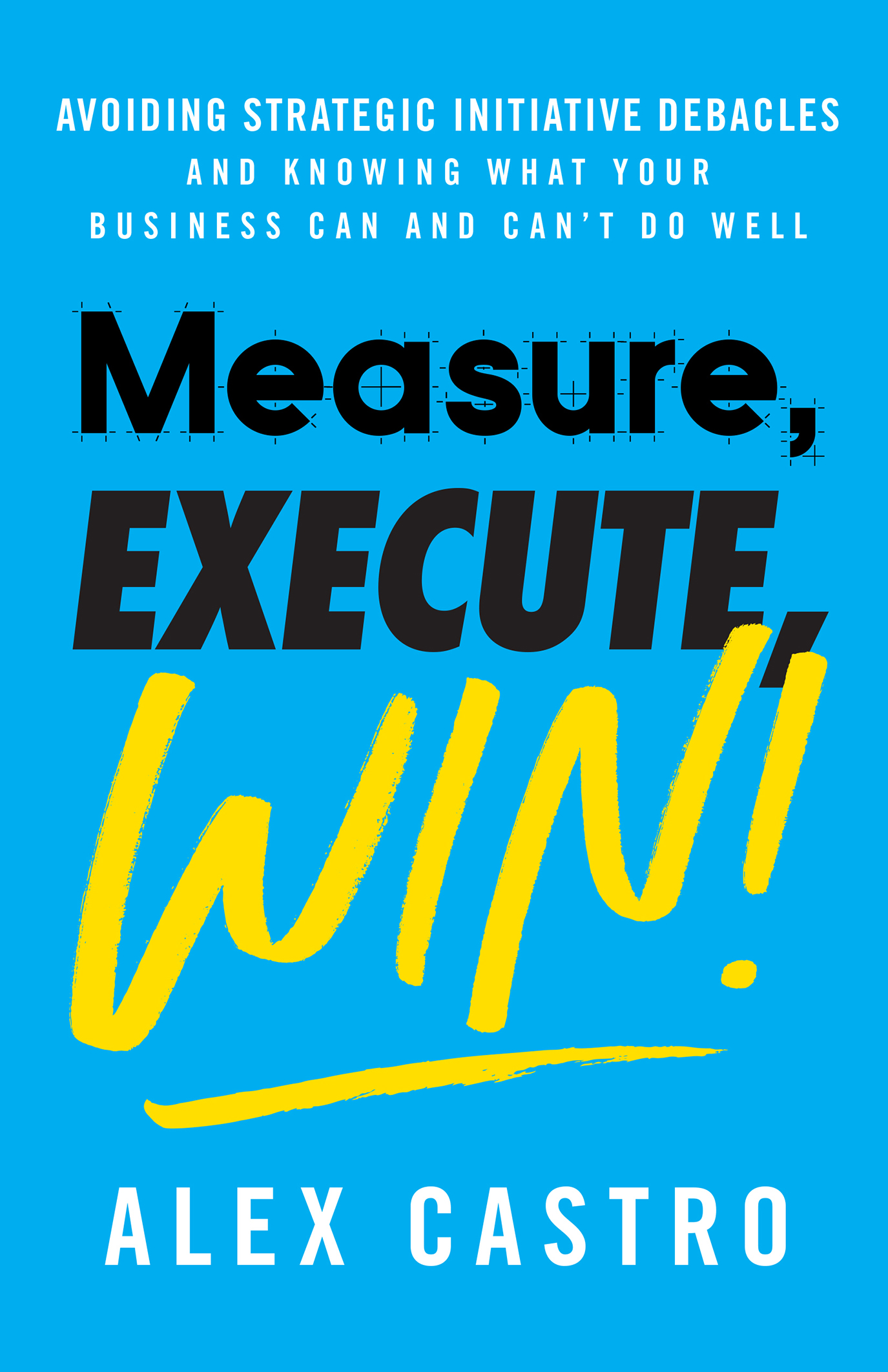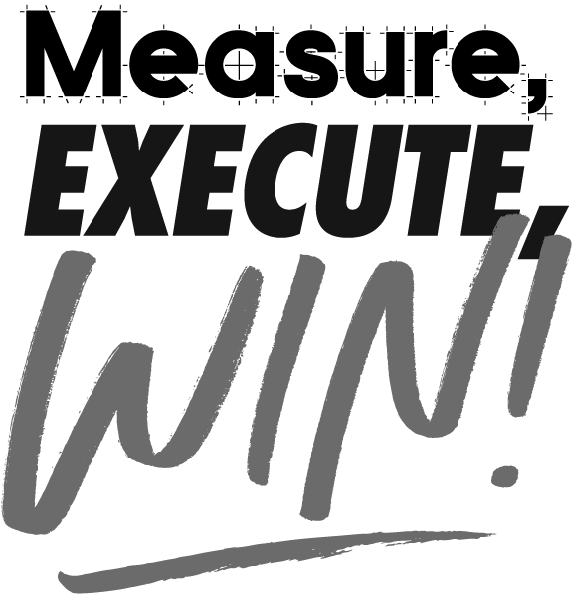
Avoiding Strategic Initiative
Debacles and Knowing What Your Business Can and Cant Do Well


copyright 2019 alex castro
All rights reserved.
measure, execute, win
Avoiding Strategic Initiative Debacles and Knowing What Your Business Can and Can't Do Well
ISBN 978-1-5445-1335-5 Paperback
ISBN 978-1-5445-1334-8 Ebook
Cover design by Michael Nagin
Book design by John van der Woude
To I.C., R.C., and M.M. Just think of all the time you could get back in your lives if only I had written this book sooner. Love you.
Part one: The Power of Measurement
Chapter 1.
Chapter 2.
Chapter 3.
Part Two: Measuring Execution Capability
Chapter 4.
Chapter 5.
Chapter 6.
Part Three: Finding Your Golden Ticket
Chapter 7.
Chapter 8.
Vision without execution is hallucination.
Thomas Edison, Henry Ford, and literally every ceo after them
Its only by saying no that you can concentrate on the things that are really important.
Steve Jobs
Fifty percent of all strategic decisions fail.
Think about the top ten initiatives in your organization today. How confident are you that your teams can move forward on them? Is that confidence, or lack of confidence, based on opinion, past performance, or a hunch?
Great leaders are no longer differentiated by having a vision for the future, innovative ideas, disrupting markets, understanding their customers, or having the courage to do what others have been afraid to do. These days, the differentiator comes from understanding their ability to execute.
This book is intended to help leaders identify those activities and initiatives that might have great potential but no real chance of delivering on promises.
To do that, leaders need an entirely new kind of metric, one that provides an execution capability (or readiness) score for each initiative being considered. With this information, leaders can balance their decision-making processes toward those initiatives, which they actually have a good chance to execute successfully.
This metric is called the ReM Score.
You will discover the power and purpose of this game-changing measurement in the coming chapters.
Why Strategic Decisions Fall Short
Leaders create a strategy, identify its potential, and largely justify their ability to realize it with biased beliefs that support their vision. Imagine a bank making a loan based solely on your loan application and financials without bothering to check your credit score. Imagine a university that looked at your high school transcripts but didnt bother to check your sat score. Imagine buying bonds based solely on the reputation of a municipality without ever looking at the bond rating.
When executives dont measure their companys ability to execute on strategies, they lack the necessary data in decision-making to avoid the debacles that slow the growth of their business and erode their return-on-invested-capital ( roic ) ratio, investor and customer confidence.
To thrive in todays one shot to get it right market, companies must integrate an execution capability score as a core decision-making metric, articulating their ability to implement a strategyno longer relying on opinion or feeling.
All too often, leaders put out a vision and strategy and then start producing products, buying companies, or moving into new markets with no clear sense of whether or not they actually have the ability to execute on that vision. They tell themselves, This will take us three, six, or nine months to achieve.
But eighteen months, twenty-four months, or thirty-six months pass, and they havent achieved their goal. The product misses the window of opportunity. The acquisition falls short in its performance because it failed to integrate into the culture. The company struggles to find footing in the new market. The initiative ends up costing two, three, or four times what they budgeted, and leaders have no idea why.
Suddenly, they are forced to rob Peter to pay Paul in order to bolster earnings because the strategy isnt performing at the level they anticipated. Consequently, they end up piling even more new things on top of the previous strategy in order to create additional growth to meet expectations.
What if, instead, an executive could decide on an initiative with complete confidence because they knew their company had the capacity to deliver? What if leaders, as part of the decision process, measured their ability to execute on each of the initiatives necessary to realize a vision and knew exactly where the gaps were and exactly where the company was vulnerable? What if leaders could approach an analyst call or media event and show that theyd fully measured everything they invested or plan to invest in?
Is such confidence possible? Absolutely, but it requires a shift in thinking. Leaders arent struggling from a lack of great business ideas. The struggle comes from a gross misunderstanding about their own companies execution capability of those ideas.
The Dangers of Decision Bias
Over the past twenty years, evidence indicates that decision-making biases are killing big businesses. Executives believe they have some special insightthe secret saucethat enables them to see what others dont see. In reality, theyre no more insightful, and no better at predicting success, than your average stockbroker. In other words, theyre mostly crossing their fingers and hoping their existing resources can get them there.
However, in many cases, the next acquisition, product launch, new market expansion, or back-office optimization not only has to increase their current numbers, it has to make up for past strategies that did not meet predicted targets. Failing that, common go-tos such as stock buybacks take their place.
In an era of ever-changing strategy and market evolution, companies are struggling to meet expectations. Theyre falling short on earnings per share ( eps ). As of this writing, eps calculations are negative for more than half of the s&p 500. It costs almost twice as much to get a dollar of earning as it used to.
In many of the companies that are struggling to make their numbers, leaders attempt to fill in the gaps in their understanding. In the absence of data, they bridge those gaps with their own biases, often based on past experience. As a result, they are held back by the very decision-making process that is intended to help them make progress.
Its not the fault of a product manager, or an acquisitions team, or a project management office. By the time the initiative gets to those people, its already too late, and the company is doing damage control, whether they realize it or not.


